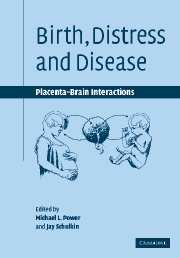Book contents
- Frontmatter
- Contents
- List of contributors
- Preface
- Introduction: brain and placenta, birth and behavior, health and disease
- 1 Placental expression of neurohormones and other neuroactive molecules in human pregnancy
- 2 The regulation of human parturition
- 3 Maternal nutrition and metabolic control of pregnancy
- 4 Fetal HPA activation, preterm birth and postnatal programming
- 5 Prenatal glucocorticoids and the programming of adult disease
- 6 Prenatal stress and stress physiology influences human fetal and infant development
- 7 Glucocorticoids and the ups and downs of neuropeptide gene expression
- 8 Glucocorticoid facilitation of corticotropin-releasing hormone in the placenta and the brain: functional impact on birth and behavior
- Index
Preface
Published online by Cambridge University Press: 16 October 2009
- Frontmatter
- Contents
- List of contributors
- Preface
- Introduction: brain and placenta, birth and behavior, health and disease
- 1 Placental expression of neurohormones and other neuroactive molecules in human pregnancy
- 2 The regulation of human parturition
- 3 Maternal nutrition and metabolic control of pregnancy
- 4 Fetal HPA activation, preterm birth and postnatal programming
- 5 Prenatal glucocorticoids and the programming of adult disease
- 6 Prenatal stress and stress physiology influences human fetal and infant development
- 7 Glucocorticoids and the ups and downs of neuropeptide gene expression
- 8 Glucocorticoid facilitation of corticotropin-releasing hormone in the placenta and the brain: functional impact on birth and behavior
- Index
Summary
In the summer of 2002, a small one-day conference was held at the offices of the American College of Obstetricians and Gynecologists in Washington DC. The purpose of the conference was to consider the implications of the intriguingly converging research areas of peptide regulation by steroids in both brain and placenta, and how these research findings might enhance our understanding of the physiological processes of human gestation and parturition. An important subtext of the discussion was how events and processes at the beginning of life can affect health and well-being decades later. Among the participants were both clinicians and basic scientists; the research presented concerned both human studies and comparative research on animal models; the perspectives examined ranged from clinical medicine to evolutionary biology.
Our understanding of the physiological and regulatory processes that underlie the timing and progression of labor and delivery remains incomplete. Perhaps the most graphic indication of our inadequate understanding of this fundamental biological process is the current lack of accurate and effective clinical tools to either predict or prevent preterm birth. In the USA, the rate of preterm birth continues to rise, and half of preterm births are classified as idiopathic.
- Type
- Chapter
- Information
- Birth, Distress and DiseasePlacental-Brain Interactions, pp. xi - xiiPublisher: Cambridge University PressPrint publication year: 2005

